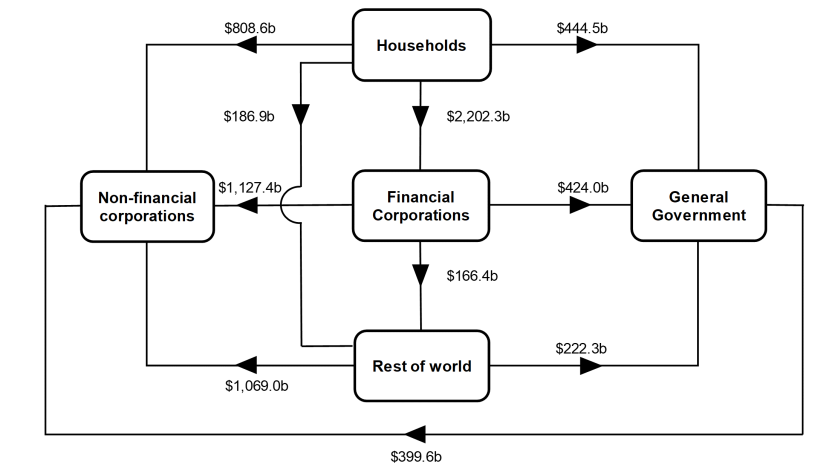Change in authorised deposit taking institutions' liabilities
[["Jun-09","Sep-09","Dec-09","Mar-10","Jun-10","Sep-10","Dec-10","Mar-11","Jun-11","Sep-11","Dec-11","Mar-12","Jun-12","Sep-12","Dec-12","Mar-13","Jun-13","Sep-13","Dec-13","Mar-14","Jun-14","Sep-14","Dec-14","Mar-15","Jun-15","Sep-15","Dec-15","Mar-16","Jun-16","Sep-16","Dec-16","Mar-17","Jun-17","Sep-17","Dec-17","Mar-18","Jun-18","Sep-18","Dec-18","Mar-19","Jun-19","Sep-19","Dec-19","Mar-20","Jun-20","Sep-20","Dec-20","Mar-21","Jun-21","Sep-21","Dec-21","Mar-22","Jun-22"],[[23.399999999999999],[75.099999999999994],[14.5],[24.199999999999999],[6.9000000000000004],[35],[-2.1000000000000001],[37.299999999999997],[-0.69999999999999996],[74.400000000000006],[-18.100000000000001],[27.300000000000001],[56.899999999999999],[61],[30.699999999999999],[43.100000000000001],[92.599999999999994],[55],[100.2],[36.700000000000003],[59.100000000000001],[70.900000000000006],[146.09999999999999],[176.19999999999999],[-72.799999999999997],[111.7],[52],[-8.8000000000000007],[77.200000000000003],[1.8],[119.3],[-23.699999999999999],[35.200000000000003],[-15.9],[45.5],[35.5],[54.100000000000001],[12.5],[10.300000000000001],[41.5],[124.5],[121.2],[-89.400000000000006],[327.5],[-99.900000000000006],[-73.900000000000006],[102.2],[0.69999999999999996],[55.200000000000003],[131.59999999999999],[98.299999999999997],[164.80000000000001],[203.59999999999999]],[[0.69999999999999996],[11.699999999999999],[6.7000000000000002],[14],[40.399999999999999],[49.200000000000003],[26.600000000000001],[38.5],[23.800000000000001],[63],[-1.3],[2.2999999999999998],[52.5],[47.899999999999999],[31.699999999999999],[1.2],[14.1],[50.700000000000003],[40.5],[15.4],[34.399999999999999],[37.299999999999997],[37.899999999999999],[42.5],[7.5999999999999996],[65.900000000000006],[22.899999999999999],[9.8000000000000007],[50.5],[42.5],[67.799999999999997],[1.3999999999999999],[34.600000000000001],[0.29999999999999999],[33.700000000000003],[10.199999999999999],[13.699999999999999],[32.799999999999997],[1.8],[7.9000000000000004],[23.100000000000001],[52.5],[1.7],[164.69999999999999],[24.899999999999999],[68.599999999999994],[-11.199999999999999],[50.5],[44.600000000000001],[92.799999999999997],[71],[47.799999999999997],[79.5]],[[19.800000000000001],[-18.800000000000001],[-2.2999999999999998],[-3.6000000000000001],[3.2000000000000002],[-29.399999999999999],[11],[6],[-5.5999999999999996],[8],[3.8999999999999999],[6.2999999999999998],[-5],[-20.600000000000001],[9.5],[6.5999999999999996],[31],[-17.899999999999999],[1.8],[13.699999999999999],[18.300000000000001],[-5.7999999999999998],[20.100000000000001],[11.199999999999999],[9.5999999999999996],[-2.3999999999999999],[5.7999999999999998],[-18.699999999999999],[0.10000000000000001],[-11.199999999999999],[14.1],[1.1000000000000001],[17.100000000000001],[11.4],[-13.300000000000001],[11.300000000000001],[3.3999999999999999],[-29.300000000000001],[22.600000000000001],[-1.5],[-24.300000000000001],[-6.2999999999999998],[22.399999999999999],[-15],[-23.800000000000001],[-27.100000000000001],[16.899999999999999],[17.5],[6.0999999999999996],[22.199999999999999],[48.200000000000003],[-12.199999999999999],[31.600000000000001]],[[-17.399999999999999],[-4.2000000000000002],[40.600000000000001],[2.2999999999999998],[13.1],[-13],[-18.399999999999999],[-5.9000000000000004],[-4.2000000000000002],[24],[-22.699999999999999],[4],[-2.7000000000000002],[6.2999999999999998],[-16.399999999999999],[-10],[14.199999999999999],[6],[14.9],[-5.0999999999999996],[2.7000000000000002],[15.699999999999999],[18.300000000000001],[11.1],[10.199999999999999],[29.100000000000001],[0.80000000000000004],[0.10000000000000001],[13.5],[-12.5],[-7.2000000000000002],[-15.6],[3.2000000000000002],[0.59999999999999998],[6.2999999999999998],[25.699999999999999],[8.8000000000000007],[14.5],[4.5999999999999996],[-9.3000000000000007],[12.5],[6.4000000000000004],[-27.300000000000001],[45.899999999999999],[-49.100000000000001],[-28.199999999999999],[-14.800000000000001],[-28.800000000000001],[5.4000000000000004],[-8.5999999999999996],[-0.69999999999999996],[-1.6000000000000001],[20.5]],[[-5.9000000000000004],[4.0999999999999996],[-32],[8.6999999999999993],[8.6999999999999993],[17.699999999999999],[-17],[-6.2000000000000002],[-5.2000000000000002],[3.5],[4.2000000000000002],[-8.8000000000000007],[22.600000000000001],[-4.7999999999999998],[-10.5],[-5.7999999999999998],[31.899999999999999],[-18.100000000000001],[17.100000000000001],[-3.7999999999999998],[1.3],[37.700000000000003],[44.100000000000001],[40.200000000000003],[-55.799999999999997],[52.100000000000001],[-32],[55.5],[14.1],[-33.700000000000003],[-4.5],[-32.899999999999999],[11.9],[-28],[11.5],[6.5999999999999996],[18.699999999999999],[-9.0999999999999996],[20.600000000000001],[13.9],[58.600000000000001],[52.700000000000003],[-38.299999999999997],[205.90000000000001],[-70],[-54.899999999999999],[35.799999999999997],[-99.599999999999994],[-29.699999999999999],[-11.800000000000001],[1.3],[95.299999999999997],[152.59999999999999]],[[-1.8],[-13.5],[5.5],[-14.9],[-4.9000000000000004],[-13.1],[1.8999999999999999],[-2.7999999999999998],[5.4000000000000004],[6.5],[-14.4],[2.7000000000000002],[-5.0999999999999996],[0.40000000000000002],[-3.2999999999999998],[0.69999999999999996],[1.7],[0.5],[4.9000000000000004],[0.59999999999999998],[1.2],[9],[-6.7000000000000002],[1.1000000000000001],[2.8999999999999999],[7],[5.2999999999999998],[0.90000000000000002],[-2],[-4.0999999999999996],[3.7000000000000002],[-3.7000000000000002],[4.7999999999999998],[-3.1000000000000001],[6.5999999999999996],[4.5999999999999996],[-0.29999999999999999],[5],[-1.3],[12.199999999999999],[8.9000000000000004],[8.4000000000000004],[-1],[37.200000000000003],[-20.300000000000001],[-12.800000000000001],[-1.3999999999999999],[-4.9000000000000004],[-0.90000000000000002],[1.7],[9.6999999999999993],[3.2999999999999998],[11.699999999999999]],[[26.899999999999999],[95.599999999999994],[-4.0999999999999996],[18.5],[-53.5],[23.800000000000001],[-5],[6.5999999999999996],[-14.800000000000001],[-31],[13],[19.399999999999999],[-5.0999999999999996],[30.600000000000001],[19.100000000000001],[50],[-3.7999999999999998],[33],[21.600000000000001],[13.4],[0.69999999999999996],[-22.300000000000001],[31.399999999999999],[65.700000000000003],[-49.200000000000003],[-39.600000000000001],[49.200000000000003],[-58.399999999999999],[-0.69999999999999996],[20.5],[48.5],[26.800000000000001],[-38.700000000000003],[2.5],[4.7999999999999998],[-29.300000000000001],[13.6],[-6],[-33.200000000000003],[12.5],[39.899999999999999],[12.5],[-41.200000000000003],[-131.09999999999999],[44.700000000000003],[-20.199999999999999],[85],[60.200000000000003],[32.100000000000001],[25],[-17.100000000000001],[22.199999999999999],[-93.5]],[[1.2],[0.29999999999999999],[0.20000000000000001],[-0.90000000000000002],[-0.10000000000000001],[-0.20000000000000001],[-1.3],[0.90000000000000002],[-0.10000000000000001],[0.29999999999999999],[-0.80000000000000004],[1.5],[-0.29999999999999999],[1.2],[0.69999999999999996],[0.5],[3.3999999999999999],[0.80000000000000004],[-0.69999999999999996],[2.6000000000000001],[0.59999999999999998],[-0.69999999999999996],[1.1000000000000001],[4.2000000000000002],[1.8],[-0.40000000000000002],[-0.10000000000000001],[2.1000000000000001],[1.7],[0.40000000000000002],[-3.2000000000000002],[-0.80000000000000004],[2.2999999999999998],[0.5],[-4.2000000000000002],[6.4000000000000004],[-3.6000000000000001],[4.5999999999999996],[-4.7999999999999998],[5.7999999999999998],[5.9000000000000004],[-5.0999999999999996],[-5.7000000000000002],[19.899999999999999],[-6.2999999999999998],[0.59999999999999998],[-8.0999999999999996],[5.7000000000000002],[-2.3999999999999999],[10.4],[-14],[9.9000000000000004],[1.2]]]
[]
[{"value":"0","axis_id":"0","axis_title":"","axis_units":"","tooltip_units":"","table_units":"","axis_min":null,"axis_max":null,"tick_interval":"4","precision":"-1","data_unit_prefix":"","data_unit_suffix":"","reverse_axis":false}][{"value":"0","axis_id":"0","axis_title":"$b","axis_units":"","tooltip_units":"($b)","table_units":"($b)","axis_min":"-300","axis_max":"600","tick_interval":"100","precision":"-1","data_unit_prefix":"","data_unit_suffix":"","reverse_axis":false}]
